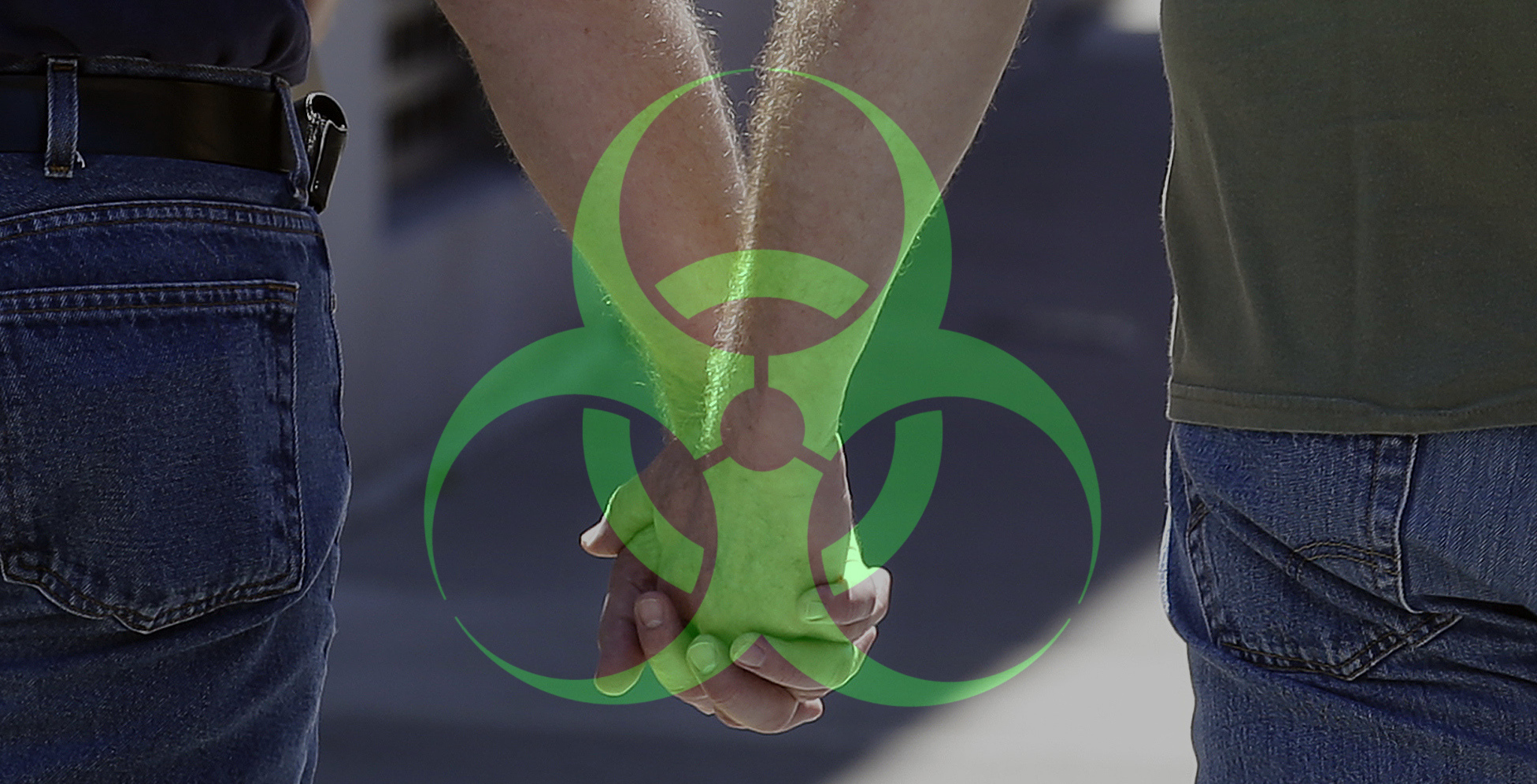For years, since the beginning of the AIDS crisis, diverse voices have been calling for a radical remaking of “gay” male culture away from the swinging sex of the 1970s into a more domesticated phase of what “gay” author Gabriel Rotello described, in his landmark 1997 book “Sexual Ecology: AIDS and the Destiny of Gay Men,” as the adoption of “serial monogamous” relationships in order to stave off the inevitably of a “China Syndrome” effect whereby homosexual men, through rampant promiscuity, will eventually destroy themselves. Strangely enough, this concept has its roots in the dissident theology of several Catholic writers from the 1970s, most notably “gay” Jesuit priest John J. McNeill, who, as early as 1970, argued in favor of the possible moral goodness and inherent social benefits from encouraging stable homosexual relationships; subsequently putting forth a very post-AIDS theory of “ethically responsible homosexual relationships” during the pre-epidemic era of the bathhouse and the discotheque; later, he wrote: “Usually after a period of sexual and social experimentation, a gay man or lesbian woman will yearn for a more stable, committed relationship that combines both physical and emotional attraction.” Afterward, prominent “gay” Catholic commentator Andrew Sullivan wrote: “As it has become more acceptable for gay people to acknowledge their loves publicly, more and more have committed themselves to one another for life in full view of their families and their friends, a law institutionalizing gay marriage would merely reinforce a healthy social trend. It would also, in the wake of AIDS, qualify as a genuine public health measure.” Recently, award-winning novelist, writer on “gay” spirituality, and former Catholic seminarian Toby Johnson wrote: “What society provides for people to control their sexuality is support from stable relationships; marriage is the cure for promiscuity. So those who blame gay people for being promiscuous ought logically to be in favor of gay marriage.”
The reality is far different:
 Fact #1: When “gay” men partner-up, enter into “stable” relationships, and or marry – they overwhelming tend to engage in condomless anal intercourse; for example, unprotected sex was eight times more likely in serious relationships than in casual encounters; and, this form of sex, remains by far the most effective way of transferring the HIV virus; according to the CDC: “Anal sex is the highest-risk sexual behavior. Receptive anal sex (bottoming) is riskier than insertive anal sex (topping).” Overall, in “gay” men: “Unprotected anal sex at least once in the past 12 months increased from 48% in 2005 to 57% in 2011.”
Fact #1: When “gay” men partner-up, enter into “stable” relationships, and or marry – they overwhelming tend to engage in condomless anal intercourse; for example, unprotected sex was eight times more likely in serious relationships than in casual encounters; and, this form of sex, remains by far the most effective way of transferring the HIV virus; according to the CDC: “Anal sex is the highest-risk sexual behavior. Receptive anal sex (bottoming) is riskier than insertive anal sex (topping).” Overall, in “gay” men: “Unprotected anal sex at least once in the past 12 months increased from 48% in 2005 to 57% in 2011.”
The evidence:
“Of the men in relationships, 62% had engaged in UAI with their steady partner.”
“Relationship characteristics and risk of HIV infection: the Rusbult investment model and sexual risk behavior of gay men in steady relationships”
Udi Davidovich, et al.
Journal of Applied Social Psychology. 2006, 36: 22-40.
“The largest effect was for considering the relationship to be serious, which was associated with nearly an eight-fold increase in the rate of unprotected sex.”
“Relationship characteristics and sexual risk-taking in young men who have sex with men”
Brian Mustanski, et al.
Health Psychol. 2011 Sep; 30(5): 597–605.
“Overall, 65% of the sample engaged in UAI with primary partner…”
“Relationship Characteristics Associated with Sexual Risk Behavior Among MSM in Committed Relationships”
Colleen C. Hoff, Ph.D., et al.
AIDS Patient Care and STDs. November 2012, 26(12): 738-745.
“Condomless sex was the rule rather than the exception with partners in a relationship: 63% never used them with their regular partner and even 46% who had other regular partners did not use them with their primary partner.”
“Monopoly: a study of gay men’s relationships, report 2014.”
Prestage G, et al.
The Kirby Institute, University of New South Wales. ISBN-10: 0-7334-3604-8. 2014
“Consistent with hypotheses and previous research, being in a serious relationship was associated with an increased rate of unprotected sex…In fact, the rate of unprotected sex appeared to increase incrementally as the likelihood that partners were familiar and/or more intimate with one another increased.”
“The Effects of Sexual Partnerships and Relationship Characteristics on Three Sexual Risk Variables in Young Men Who Have Sex with Men”
Michael E. Newcomb, et al.
Arch Sex Behav. 2014 Jan; 43(1): 61–72.
 Fact #2: HIV becomes an almost immediate threat to “gay” couples because the majority or near majority of so-called “stable” committed “gay” relationships are actually negotiated non-monogamous partnerships.
Fact #2: HIV becomes an almost immediate threat to “gay” couples because the majority or near majority of so-called “stable” committed “gay” relationships are actually negotiated non-monogamous partnerships.
The evidence:
“Ninety nine percent of couples reported having an agreement. Specifically, 45% had monogamous agreements, 47% had open agreements, and 8% reported discrepant agreements.”
“Relationship Characteristics and Motivations behind Agreements among Gay Male Couples: Differences by Agreement Type and Couple Serostatus”
Colleen C. Hoff, PhD., et al.
AIDS Care. 2010 Jul; 22(7): 827–835.
“Of all participants with steady partners, (52.5%) had a concurrent casual partner, and (30.3%) performed UAI with both the steady and the casual partner. Of all participants with steady partners, (85.4%) negotiated the possibility of sex outside their relationship with their main partner.”
“High-risk behavior in steady and in casual relationships among men who have sex with men in Israel.”
Mor Z, et al.
Sex Transm Infect. 2011 Oct;87(6):532-7.
“Within the total sample, 81% of men who reported having anal sex with their main partner in the past 90 days said that condoms were not used at least once. Nearly 55% of the total sample reported having anal sex with one or more non-main partners.”
Open, Closed, or In Between: Relationship Configuration and Condom Use among Men Who Use the Internet to Seek Sex with Men
Sonya S. Brady, et al.
AIDS Behav. 2013 May; 17(4): 1499–1514.
“About half of the participants believed their last partner had sex with other partners outside of the relationship and about half self-reported having sex with other partners outside of the relationship.”
DC HIV Behavior Study Series #2, MSM in DC: A Life Long Commitment to Stay HIV Free
District of Columbia Department of Health HIV/AIDS Administration (2013)
“More than half (63.2%) described having concurrent sex partners; 71.5% reported having partners whom they believed had concurrent partners; and 56.1% reported that both they and their partners had concurrent partners.”
“Concurrent partnerships and HIV risk among men who have sex with men in New York City.”
Tieu HV, et al.
Sex Transm Dis. 2014 Mar;41(3):200-8.
“Some couples reported a change in the type of sexual agreement they had currently compared with when they originally established one. Specifically, over half of the men (63%) indicated that their original type of sexual agreement with their main partner was ‘We only have sex with each other and no one else,’ 34% reported ‘We have sex with each other, and we are allowed to have sex with others under certain guidelines/rules’ and 3% of the men chose ‘We have sex with each other, and are allowed to have sex with others without any guidelines/rules.’ When asked about their current type of sexual agreement, fewer men (56%) chose ‘We only have sex with each other and no one else’ while more (41%) selected ‘We have sex with each other, and we are allowed to have sex with others under certain guidelines/rules.’”
“Characteristics and allowed behaviors of gay male couples’ sexual agreements”
Jason W. Mitchell
J Sex Res. 2014; 51(3): 316–328.
 Fact #3: Because most “gay” male couples practice some form of serial non-monogamy, the vast majority of HIV infections in the “gay” male community occur within the context of a “stable” relationship; in other words, currently, most “gay” men who contract HIV – were infected by their main partner, boyfriend, or husband.
Fact #3: Because most “gay” male couples practice some form of serial non-monogamy, the vast majority of HIV infections in the “gay” male community occur within the context of a “stable” relationship; in other words, currently, most “gay” men who contract HIV – were infected by their main partner, boyfriend, or husband.
The evidence:
“Currently, 86% (range 74-90%) of new HIV infections occur within steady partnerships.”
“The contribution of steady and casual partnerships to the incidence of HIV infection among homosexual men in Amsterdam.”
Xiridou M, et al.
AIDS. 2003 May 2;17(7):1029-38.
“Sixty-eight percent of HIV transmissions were from main sex partners because of a higher number of sex acts with main partners, more frequent receptive roles in anal sex with main partners, and lower condom use during anal sex with main partners.”
“Estimating the proportion of HIV transmissions from main sex partners among men who have sex with men in five US cities.”
Sullivan PS, et al.
AIDS. 2009 Jun 1;23(9):1153-62.
“Nearly 70% of HIV+ MSM are estimated to have contracted HIV from a main partner…Our data suggest that reported monogamy may sometimes reflect intent or a non-traditional definition of monogamy rather than engagement in sex with only one partner. Nearly a quarter of men who indicated that they had only had sex with their partner for the duration of their relationship also reported engagement in anal sex with at least one non-main partner in the past 90 days. This supports previous research showing ‘monogamy’ to be an ambiguous term…”
“Open, Closed, or In Between: Relationship Configuration and Condom Use among Men Who Use the Internet to Seek Sex with Men”
Sonya S. Brady, et al.
AIDS Behav. 2013 May; 17(4): 1499–1514.
“Men who have sex with men (MSM) in primary relationships engage in condomless sex both within and outside their relationships and a majority of HIV transmission risk may actually occur within primary relationships.”
“Relationship Power, Sociodemographics, and Their Relative Influence on Sexual Agreements Among Gay Male Couples.”
Perry NS, et al.
AIDS Behav. 2015 Sep 21.
Postscript:
It’s interesting that the situation regarding HIV and “stable” male couples seems to be the worst in traditionally “gay” inclusive nations with a long history of homosexual rights; namely in Israel – the first and only country in Asia to recognize same-sex unions; since 1992, discrimination on the grounds of sexual orientation is prohibited, and since 2008, “gay” couples have been able to jointly adopt; and, The Netherlands – the first country in the world to legalize same-sex unions.





Well documented and nicely articulated. Someone send this to our bishops, please!
I had no idea gay marriage was a big risk factor for HIV. Why is this not better understood?
I have a couple of friends who have been together since the 1980’s. Supposedly monogamous. They went to buy a house together. The had to buy life insurance as part of the mortgage process (or in order to protect the investment). As part of being evaluated for life insurance, they had to be tested for HIV. Surprise. One of the men was positive. This was after 10 years of “monogamy.”
I asked, “What happened???”
“Well, [redeacted] liked to pick men up at the[various transit hub].
This happens and more than you think. Both men now live in continence and attend the Orthodox Rite. G-d writes straight with crooked lines.